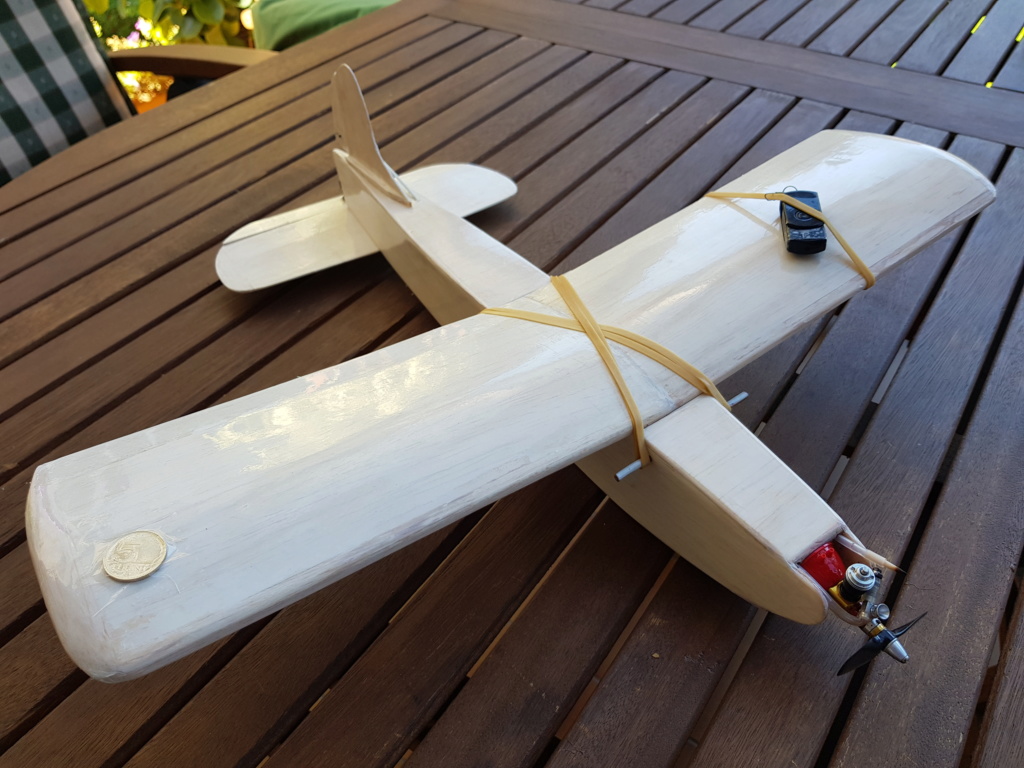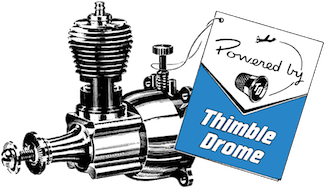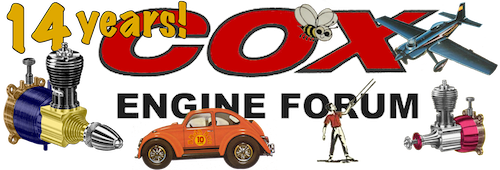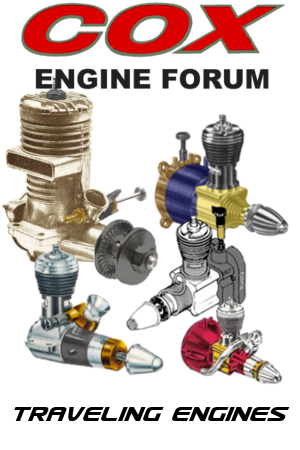Log in
Search
Latest topics
» Stealth SB-Xby Admin Yesterday at 8:28 pm
» ST .35 STUNT / VOODOO / ZERO POINT ZERO NITRO
by TD ABUSER Yesterday at 7:45 pm
» SUPERTIGER .15 PROJECT
by TD ABUSER Yesterday at 7:42 pm
» For sale -- Cox Custom Carburetors for Tee Dee engines
by sosam117 Yesterday at 5:23 pm
» WHERE ARE YOU BUYING YOUR FUEL AND GLOW PLUGS...?
by TD ABUSER Yesterday at 4:35 pm
» Waiting for Engines from Ken Enya
by sosam117 Yesterday at 4:33 pm
» Unusual Cox 049 cylinder - Need help identifying
by anm2 Yesterday at 4:12 pm
» Jim Walker Bonanza etc.
by rsv1cox Yesterday at 2:57 pm
» What's the Best Reed for Cox Reed Valve Engines.
by roddie Yesterday at 1:37 pm
» Fuel choice
by 1975 control line guy Fri Aug 30, 2024 4:01 pm
» "Fall S.M.A.L.L." Video 3.
by GallopingGhostler Fri Aug 30, 2024 2:37 pm
» Gifted Fox
by Ken Cook Fri Aug 30, 2024 11:12 am
Cox Engine of The Month
August-2024
balogh's

"Cox TD09 R/C Beast of Burden featuring Kamtechnik head and DIY metallic fuel nipple"

PAST WINNERS
balogh's

"Cox TD09 R/C Beast of Burden featuring Kamtechnik head and DIY metallic fuel nipple"

PAST WINNERS
On-board flight video with COX TEE DEE 010
Page 1 of 1
 On-board flight video with COX TEE DEE 010
On-board flight video with COX TEE DEE 010
I got this small spy camera off of ebay (7 USD or so, free shipping from China) and mounted on my smallest RC plane, the Roaring 20, powered by my COX Tee Dee010...

The COX Tee Dee 010 proves another time that it is a real beast of burden... It pulled the plane with authority, that weighs around 193 grams when dry, and with the camera and a small coin to balance on the other wing the dry weight grew to 208 grams...added some 10 grams of fuel, here is the vid
The quality is not what Hollywood would release, (this is a 7 USD camera !!!) and by the end of the flight the lens got splashed in castor even if I tried to mount the camera off the stream of flue gases..
Buckle up and enjoy...

The COX Tee Dee 010 proves another time that it is a real beast of burden... It pulled the plane with authority, that weighs around 193 grams when dry, and with the camera and a small coin to balance on the other wing the dry weight grew to 208 grams...added some 10 grams of fuel, here is the vid
The quality is not what Hollywood would release, (this is a 7 USD camera !!!) and by the end of the flight the lens got splashed in castor even if I tried to mount the camera off the stream of flue gases..
Buckle up and enjoy...
Last edited by balogh on Mon Aug 03, 2020 8:18 am; edited 2 times in total

balogh- Top Poster



Posts : 4852
Join date : 2011-11-06
Age : 65
Location : Budapest Hungary
 Re: On-board flight video with COX TEE DEE 010
Re: On-board flight video with COX TEE DEE 010
Curious video Andras, 236/436 something happened around 2:25. Enjoyed it, a page right out of Kim's book who has been rather quiet lately.
Love the sound of the 0.10 which is different in the air. Mine always sounded like a bumble bee on the test stand.
Love the plane too, but also curious about the low position of the horizontal stabliator rather than mid section?
Bob
Love the sound of the 0.10 which is different in the air. Mine always sounded like a bumble bee on the test stand.
Love the plane too, but also curious about the low position of the horizontal stabliator rather than mid section?
Bob

rsv1cox- Top Poster




Posts : 10928
Join date : 2014-08-18
Location : West Virginia
 Re: On-board flight video with COX TEE DEE 010
Re: On-board flight video with COX TEE DEE 010
Thanks Bob,
looks like the uploading to youtube was not perfect, the original video does not have that freeze...I will try to upload it again.
Yes, the Roaring 20 is a strange little plane, the horizontal stab was designed to be below the fuselage...I am not sure why the designer put it there, and did not want to change it for fears that its flight characteristics will be impaired.
Thanks, András
looks like the uploading to youtube was not perfect, the original video does not have that freeze...I will try to upload it again.
Yes, the Roaring 20 is a strange little plane, the horizontal stab was designed to be below the fuselage...I am not sure why the designer put it there, and did not want to change it for fears that its flight characteristics will be impaired.
Thanks, András

balogh- Top Poster



Posts : 4852
Join date : 2011-11-06
Age : 65
Location : Budapest Hungary
 Re: On-board flight video with COX TEE DEE 010
Re: On-board flight video with COX TEE DEE 010
Heheh lovely András / 26k to 28,670 a great way to measure in flight rpm!







1/2A Nut- Top Poster

- Posts : 3464
Join date : 2013-10-20
Age : 61
Location : Brad in Texas
 Re: On-board flight video with COX TEE DEE 010
Re: On-board flight video with COX TEE DEE 010
Thanks Brad..on another vid that became too blurred because of castor splashing the lens the engine licked into the upper 29k..a few years back my 010- s ran near 30 when unloading...nowadays they are a bit slower..maybe the nitro I am using has absorbed air humidity?

balogh- Top Poster



Posts : 4852
Join date : 2011-11-06
Age : 65
Location : Budapest Hungary
 Re: On-board flight video with COX TEE DEE 010
Re: On-board flight video with COX TEE DEE 010
A few years back there was a shipping fire on a railway car. It had nitromethane destined for Sig I believe. Since then the shippers make it manditory to dilute it 50 / 50% with methanol. That could be the poor results. I often question the nitro content of any fuel now, Who knows the source? but nearly all my racing events are limited to 10% anyway.balogh wrote:Thanks Brad..on another vid that became too blurred because of castor splashing the lens the engine licked into the upper 29k..a few years back my 010- s ran near 30 when unloading...nowadays they are a bit slower..maybe the nitro I am using has absorbed air humidity?

aspeed- Platinum Member

- Posts : 790
Join date : 2013-01-18
Location : Leamington Ont. Can.
 Re: On-board flight video with COX TEE DEE 010
Re: On-board flight video with COX TEE DEE 010
Very good my friend !!! .... It is always beautiful to make videos of our models in action!
Powerful the Cox .010 !! of course!!
Powerful the Cox .010 !! of course!!

MauricioB- Top Poster

- Posts : 3657
Join date : 2016-02-16
Age : 53
Location : ARG
 Re: On-board flight video with COX TEE DEE 010
Re: On-board flight video with COX TEE DEE 010






 Thanks THAT WAS A GOOD 4 MINS. OF fun
Thanks THAT WAS A GOOD 4 MINS. OF fun 



 I thought it was a weed eater at first
I thought it was a weed eater at first 





getback- Top Poster



Posts : 10326
Join date : 2013-01-18
Age : 67
Location : julian , NC
 Re: On-board flight video with COX TEE DEE 010
Re: On-board flight video with COX TEE DEE 010
Thanks aspeed, Mauricio and Eric. Yes the camera is rather basic. Plus you cannot put it sufficiently far from the stream of exhaust gases. I put it midway to wing tip. Putting it on the tip would need twice the balancing weight and the flight stability would deteriorate.
Otherwise the weight would not be a problem...before revamped, the Roaring 20 weighed around 250 grams with lots of castor soaked in the fuselage and the 010 could still handle it.
Otherwise the weight would not be a problem...before revamped, the Roaring 20 weighed around 250 grams with lots of castor soaked in the fuselage and the 010 could still handle it.


balogh- Top Poster



Posts : 4852
Join date : 2011-11-06
Age : 65
Location : Budapest Hungary
 Re: On-board flight video with COX TEE DEE 010
Re: On-board flight video with COX TEE DEE 010
balogh wrote:you cannot put it sufficiently far from the stream of exhaust gases. I put it midway to wing tip. Putting it on the tip would need twice the balancing weight and the flight stability would deteriorate.
Maybe you could at least make the lens face outboard, instead of inboard, then it wouldn't get splashed with castor so easily, and the engine and prop wouldn't obscure the view. Unless the engine actually was supposed to be the main star of the video

dirk gently- Gold Member

- Posts : 430
Join date : 2012-02-03
Age : 42
Location : Poznań
 Re: On-board flight video with COX TEE DEE 010
Re: On-board flight video with COX TEE DEE 010
This is exactly the point Dirk! I wanted my 010 shown in the spotlight doing humbly what it us supposed to do: entertain the COX engine lovers.
I also shot a vid with the camera looking outboard but the film is as boring as looking out the window on a long interconti flight on coach class
I also shot a vid with the camera looking outboard but the film is as boring as looking out the window on a long interconti flight on coach class

balogh- Top Poster



Posts : 4852
Join date : 2011-11-06
Age : 65
Location : Budapest Hungary
 Re: On-board flight video with COX TEE DEE 010
Re: On-board flight video with COX TEE DEE 010
Solution is - two cameras one on each wing tip for balance with one looking at the engine and one looking forward capturing that wonderful countryside.

rsv1cox- Top Poster




Posts : 10928
Join date : 2014-08-18
Location : West Virginia
 Re: On-board flight video with COX TEE DEE 010
Re: On-board flight video with COX TEE DEE 010
balogh wrote:
Yes, the Roaring 20 is a strange little plane, the horizontal stab was designed to be below the fuselage...I am not sure why the designer put it there, and did not want to change it for fears that its flight characteristics will be impaired.
Hello,
Interesting and entertaining video concept… well worth the effort Andras…also the all-white color scheme of this model nicely contrasts with the colorful/original production .010… really enjoyable!
It is my humble belief that many vintage design models (especially trainers) used the lowered stab position for a number of good reasons all being related to basic aerodynamic formulas.
By greatly lowering the stab mounting position at the bottom of the rear fuse a substantial drag decrease can result… this drag reduction benefit is mostly associated by minimizing airflow cross interaction between the stab and fin/rudder surfaces, in a normal cross tailed model incoming airflow approaches the tail section in an already turbulent state having first encountered the forward fuse section and wing… it must then flow through the junction of the cross tail which geometrically produces four 90 degree corners and we all know very well that acute angles/sudden shape changes are huge drag producing factors.
A much lowered stab produces only two geometric angle/corners right at the junction of the fuse so it is clearly better in reducing drag… a side benefit of separating the positioning of a stab/fin/rudder is that pitch and yaw control surface induced forces are substantially enhanced and not interacting with each other… result is the same control force response with much reduced throws (less trim drag) and also undisturbed (pure to some) yaw/pitch response… some vintage pattern ships used that lowered stab concept for the above reasons.
It is also probable that a highly lowered stab may in some cases (especially long tail moment designs etc.) reduce the chance of the highly turbulent wing central wake and/or tip vortices from contacting the stab… this powerful wing wake can produce a partial or even total stab stall, a dangerous condition not easily recognized by pilots as many strange/sudden nose drops or frequent pitch oscillations are the outcome of a stab stall.
Sailplane designs use the very efficient high position T-tail (some bold originals even an inverted Vtail!) concept to escape wing wake vortices but it is not actually the same case as bottom stabs… in most designs wing tip vortices have a pronounced negative (i.e. downforce) and spiral vector line… this means that in a really short tail moment design flying at a high angle of attack a bottom positioned stab may have exactly the opposite effect and readily be a high drag source as it can meet the wing wake head on!
A nice flight handling benefit of a low stab is in takeoff and landing as it produces very smooth angle changes due to ground effect… trainers greatly benefit from that effect, also a number of vintage aerobatic models used them in times when takeoff and landing scored high points in the old era pattern schedule.
Force arrangement changes relating to fuse main datum/engine thrust lines are another issue but it gets rather complicated (to some really boring) and possibly out of my field… so I better stop now!
In truth I do not claim to have any real aerodynamic knowledge but my long association with sailplane design/building and quite a number of tough F5J competition years/seasons has taught me the value of at least basic concepts applied to practical every day flying and trimming procedures… additionally my love for Cox powered models has led me in the past to design some originals or boldly modify older designs… results are not always optimal (from the beginning at least) but the procedure is very interesting and it sure is exciting!
Sorry for the long text but sometimes simple things cannot be easily described in just a few short words!
Tasos.

kazaklisglider- Bronze Member

- Posts : 45
Join date : 2019-09-13
Age : 59
Location : Greece
 Re: On-board flight video with COX TEE DEE 010
Re: On-board flight video with COX TEE DEE 010
Wow that was a good read with some understanding of what ur saying  You have good knowledge of the consep for sure , Thank You Tasos
You have good knowledge of the consep for sure , Thank You Tasos

getback- Top Poster



Posts : 10326
Join date : 2013-01-18
Age : 67
Location : julian , NC
 Re: On-board flight video with COX TEE DEE 010
Re: On-board flight video with COX TEE DEE 010
Thanks for the video 


Levent Suberk- Diamond Member

- Posts : 2233
Join date : 2017-12-24
Location : Türkiye
 Re: On-board flight video with COX TEE DEE 010
Re: On-board flight video with COX TEE DEE 010
kazaklisglider wrote:balogh wrote:
Yes, the Roaring 20 is a strange little plane, the horizontal stab was designed to be below the fuselage...I am not sure why the designer put it there, and did not want to change it for fears that its flight characteristics will be impaired.
Hello,
Interesting and entertaining video concept… well worth the effort Andras…also the all-white color scheme of this model nicely contrasts with the colorful/original production .010… really enjoyable!
It is my humble belief that many vintage design models (especially trainers) used the lowered stab position for a number of good reasons all being related to basic aerodynamic formulas.
By greatly lowering the stab mounting position at the bottom of the rear fuse a substantial drag decrease can result… this drag reduction benefit is mostly associated by minimizing airflow cross interaction between the stab and fin/rudder surfaces, in a normal cross tailed model incoming airflow approaches the tail section in an already turbulent state having first encountered the forward fuse section and wing… it must then flow through the junction of the cross tail which geometrically produces four 90 degree corners and we all know very well that acute angles/sudden shape changes are huge drag producing factors.
A much lowered stab produces only two geometric angle/corners right at the junction of the fuse so it is clearly better in reducing drag… a side benefit of separating the positioning of a stab/fin/rudder is that pitch and yaw control surface induced forces are substantially enhanced and not interacting with each other… result is the same control force response with much reduced throws (less trim drag) and also undisturbed (pure to some) yaw/pitch response… some vintage pattern ships used that lowered stab concept for the above reasons.
It is also probable that a highly lowered stab may in some cases (especially long tail moment designs etc.) reduce the chance of the highly turbulent wing central wake and/or tip vortices from contacting the stab… this powerful wing wake can produce a partial or even total stab stall, a dangerous condition not easily recognized by pilots as many strange/sudden nose drops or frequent pitch oscillations are the outcome of a stab stall.
Sailplane designs use the very efficient high position T-tail (some bold originals even an inverted Vtail!) concept to escape wing wake vortices but it is not actually the same case as bottom stabs… in most designs wing tip vortices have a pronounced negative (i.e. downforce) and spiral vector line… this means that in a really short tail moment design flying at a high angle of attack a bottom positioned stab may have exactly the opposite effect and readily be a high drag source as it can meet the wing wake head on!
A nice flight handling benefit of a low stab is in takeoff and landing as it produces very smooth angle changes due to ground effect… trainers greatly benefit from that effect, also a number of vintage aerobatic models used them in times when takeoff and landing scored high points in the old era pattern schedule.
Force arrangement changes relating to fuse main datum/engine thrust lines are another issue but it gets rather complicated (to some really boring) and possibly out of my field… so I better stop now!
In truth I do not claim to have any real aerodynamic knowledge but my long association with sailplane design/building and quite a number of tough F5J competition years/seasons has taught me the value of at least basic concepts applied to practical every day flying and trimming procedures… additionally my love for Cox powered models has led me in the past to design some originals or boldly modify older designs… results are not always optimal (from the beginning at least) but the procedure is very interesting and it sure is exciting!
Sorry for the long text but sometimes simple things cannot be easily described in just a few short words!
Tasos.
Great description Tasos, It took me about seven minutes to digest it all.
The reason I asked is because my current rebuild is a Walter Musciano F-100 Super Sabre where he placed the horizontal stab mid ships instead of the low position of the original. Either position is possible with this model. However I believe the originals position was mandated by the fact that the exhaust/afterburner assembly occupied the midships position.
I'm changing the whole arraignment by changing the fixed H/stab/elevator assembly to a flying tail and lowering it to the bottom of the fuselage like the full-scale. I have no idea how this will affect the flying qualities of it.

rsv1cox- Top Poster




Posts : 10928
Join date : 2014-08-18
Location : West Virginia
 Re: On-board flight video with COX TEE DEE 010
Re: On-board flight video with COX TEE DEE 010
Thanks Tasos great explanation..now that I read it it really dawns on me that lowering the horizontal stab or elevating it like in sailplanes helps avoid vortices generated by the traveling edge of the wing to hit the stab...

balogh- Top Poster



Posts : 4852
Join date : 2011-11-06
Age : 65
Location : Budapest Hungary
 Re: On-board flight video with COX TEE DEE 010
Re: On-board flight video with COX TEE DEE 010
[/quote="rsv1cox"]
I'm changing the whole arraignment by changing the fixed H/stab/elevator assembly to a flying tail and lowering it to the bottom of the fuselage like the full-scale. I have no idea how this will affect the flying qualities of it. [/quote]
Hello,
A flying stab will work just fine as long as you pay some attention to the positioning and strength of the main pivot joiner wire system, avoiding flutter at high speeds is the main issue and accurate pivot point placement plus a truly no slop/accurate mechanical assembly is a must ... I suppose you already know of these requirements… will be glad to assist with some specific advise if needed.
I personally have a fond spot for all moving stabs as if done correctly can provide very smooth pitch control which can be a nice asset especially for a Cox model, many small designs really need some taming down of that jerky elevator response and this is quite difficult to achieve with a normal set up, however it can be done with careful CG positioning/ accurate throws and a relatively big stab/elevator area... to mention a few factors.
The name of Walter Musciano sure brings some truly fond memories as his book Building and flying scale-model aircraft even now provides an occasional and enjoyable read, he is (among many others) a true pioneer and inspiration to most of us… we are all most fortunate to live and share that early aeromodelling golden age!
Tasos.
I'm changing the whole arraignment by changing the fixed H/stab/elevator assembly to a flying tail and lowering it to the bottom of the fuselage like the full-scale. I have no idea how this will affect the flying qualities of it. [/quote]
Hello,
A flying stab will work just fine as long as you pay some attention to the positioning and strength of the main pivot joiner wire system, avoiding flutter at high speeds is the main issue and accurate pivot point placement plus a truly no slop/accurate mechanical assembly is a must ... I suppose you already know of these requirements… will be glad to assist with some specific advise if needed.
I personally have a fond spot for all moving stabs as if done correctly can provide very smooth pitch control which can be a nice asset especially for a Cox model, many small designs really need some taming down of that jerky elevator response and this is quite difficult to achieve with a normal set up, however it can be done with careful CG positioning/ accurate throws and a relatively big stab/elevator area... to mention a few factors.
The name of Walter Musciano sure brings some truly fond memories as his book Building and flying scale-model aircraft even now provides an occasional and enjoyable read, he is (among many others) a true pioneer and inspiration to most of us… we are all most fortunate to live and share that early aeromodelling golden age!
Tasos.

kazaklisglider- Bronze Member

- Posts : 45
Join date : 2019-09-13
Age : 59
Location : Greece
 Similar topics
Similar topics» Toucan RC rebuilt
» COX Tee Dee 09 RC powering my SIG Wonder RC plane in this on-board flight video
» PIYURIN .010 * flight video *!! and now also .020...*flight video*
» I invite you to a flight on board.
» The Sliver - a TD .020 Project
» COX Tee Dee 09 RC powering my SIG Wonder RC plane in this on-board flight video
» PIYURIN .010 * flight video *!! and now also .020...*flight video*
» I invite you to a flight on board.
» The Sliver - a TD .020 Project
Page 1 of 1
Permissions in this forum:
You cannot reply to topics in this forum

 Rules
Rules




